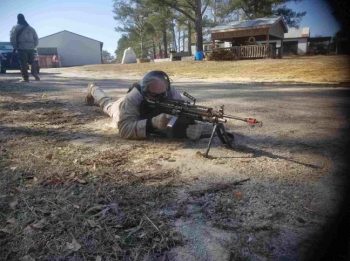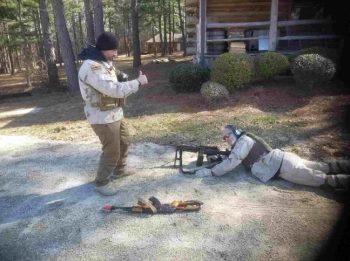Fort Bragg, NC is where a lot of our Special Forces get selected and trained.



For many Americans, Special Forces/Green Beret simply means “Super Soldier” but unappreciated by many of us is distinct skill sets for working with locals in unconventional warfare contexts– in many cases training them up to be an effective force against an oppressive government. This is why a challenge coin from a SF group features “De Oppresso Liber” meaning “To Free The Oppressed”.
One of the final steps in the selection process is Robin Sage.
Since 1974, Robin Sage, the culmination exercise for the SFQC, has been the litmus test for soldiers striving to earn the coveted Green Beret. (Prior to 1974, similar exercises were held under the name Devil’s Arrow, Swift Strike, and Guerrilla USA.) During Robin Sage, held across 15 rural North Carolina counties, soldiers put all of the skills they learned throughout the SFQC to the test in an unconventional-warfare training exercise.
The exercise, broken into two phases, puts students on their first SFODA. The SFODA is trained, advised, and mentored throughout the exercise—from mission receipt through planning and infiltration. During the first week, the students are taught the necessary skills to survive and succeed in a UW environment using the small group instruction teaching method. The remaining three weeks focus on their planning and application during Robin Sage. The students are placed into an environment of political instability characterized by armed conflict to force soldiers to exercise individual and collective problem-solving. A key to the success of the Robin Sage training is its real-world feel by the use of guerrilla forces. The SFODA must assess the combat effectiveness of the G-forces, then trains them in basic individual tasks from each of the MOSs as well as collective tasks in basic small-unit tactics, while remaining responsive to asymmetrical challenges. Just as language plays a key role in all other phases of the pipeline, language skills will be put to the test during Robin Sage. During this training, the SFODA must demonstrate their knowledge of UW doctrine and operational techniques.
The 15 counties of the People’s Republic of Pineland
On the last day of isolation, the detachment presents their plan to the battalion command and staff. This plan explains the ways the commander intends to execute the mission. The next day, the students make an airborne infiltration into the fictitious country of “Pineland”. They contact guerrilla forces to initiate Robin Sage. Students accomplish their task of training, advising, and assisting the guerrillas. The training educates the guerrillas in various specialties, including weapons, communications, medical, and demolitions. The training is designed to enable the guerrillas to begin liberating their country from oppression. It is the last portion of the Special Forces Qualification Course before they receive their “Green Berets”.
Robin Sage involves approximately 100 Special Forces students, 100 counter-insurgent personnel (OPFOR), 200 guerrilla personnel, 40 auxiliary personnel, and 50 cadre. The local communities of North Carolina also participate in the exercise by roleplaying as citizens of Pineland. The exercise is conducted in approximately 50,000 square miles (130,000 km2) of North Carolina. Many of the OPFOR and guerrilla personnel are North Carolina residents and are paid for their participation. The role of the guerrilla chief, “G-chief”, is sometimes played by a retired Green Beret. During the summer Robin Sage exercises, Army ROTC cadets from The Citadel and cadets from the United States Military Academy act as guerrilla fighters.”
In this context that this past week I got to participate as a Bad Guy. As a civilian, this is a wonderful opportunity to do a mini-reality check: Just how ready am I with my gear? Whoops, my “camel back water carrier” had a leak! Whoops– these boots require two pairs of socks so that I don’t get blisters! How heavy is all this equipment? How fast, how far, how long could I realistically move and fight in it?
While waiting for the Good Guys to attack (rumored that they were coming in rappelling from helicopters) there was time to listen to the candid telling of war and other stories from the many well-seasoned veterans on our teams. There is much of great depth to be gleaned from such stories!
Due to my lesser mobility that comes with age I was put on an M249 SAW– (Squad Auto Weapon). I was quickly trained up on how to fire one (all guns in the exercise were real and set to fire blanks only– thus the weight and noise were entirely realistic) This meant I was in kneeling position (in that I was on gravel thank God for my knee pads, which passed the test for staying in place) that both gave me pretty good cover and enabled me to rotate my line of fire 90 degrees.
As the attack came there were smoke grenades a plenty and in the chaos of the fire-fight I had a visceral experience of just how easily friendly fire could happen.
As I fired (full auto is fun!) and watched the shooting and moving of the fire fight by those with carbines (the Good Guys with M4s, the Bad Guys with AKs), I thought to myself “I’m not so old– I can do that!”. With that in mind and the next iteration of the games in three months I will be continuing and increasing the portion of my training focused on my ability to sprint.
In conclusion and summary, I would say to my fellow civilians–
- this is a great way to check on how ready you are gear wise to show up at a fire fight;
- this is a great way to learn from the stories of our war fighters;
- this is a great way to indulge in your LARPing fantasies; and
- it is a great feeling to contribute in a small way to helping our next generation of war fighters get ready.
Looking to walk as a Warrior for all my days!
PG Crafty Dog
Just a small correction on your meaning of “De Oppresso Liber,” it actually means “to free the oppressed.” You were close with Freedom of Oppression, and you honor us with your article above.
Brian Miller
MAJ US Army (Retired)
ODAs 771 & 773 from 1992-2003
Thank you Major Miller.
A moment in my civilian life of which I confess to being rather proud is that at the end of a week working with 5th SF at Fort Campbell (2005? 2006?) I received a challenge coin from both the NCOs and the Colonel, each with my name engraved on it. As I was presented with the coins, the meaning of the different parts of it were explained to me, so I am a bit embarrassed to have garbled things up a bit.
I will ask Webmaster Bob to rectify the original.
Very glad to have you with us!
Thank you very much! I have corrected the definition.
PS: What was your MOS?
I was an 18B & 18D and operated on two different teams at 7th SFG(A). I’ll see you soon with my daughter who you are now training.
I hope I didn’t upset you. It’s just I’m very picky and protective of my brothers in SF. We have a lot of wannabes or posers, as one would say, that tarnish their honor and the name of the Special Forces. You’ll see what I mean while you’re here near Bragg.
Not at all!
As a civvie moving in the circles I do I am grateful to learn.
18 Delta is combat medic (as was Frankie McRae)
What is an 18 B?
Regarding ““to free the oppressed” we may be needing some guidance in that here at home , , ,